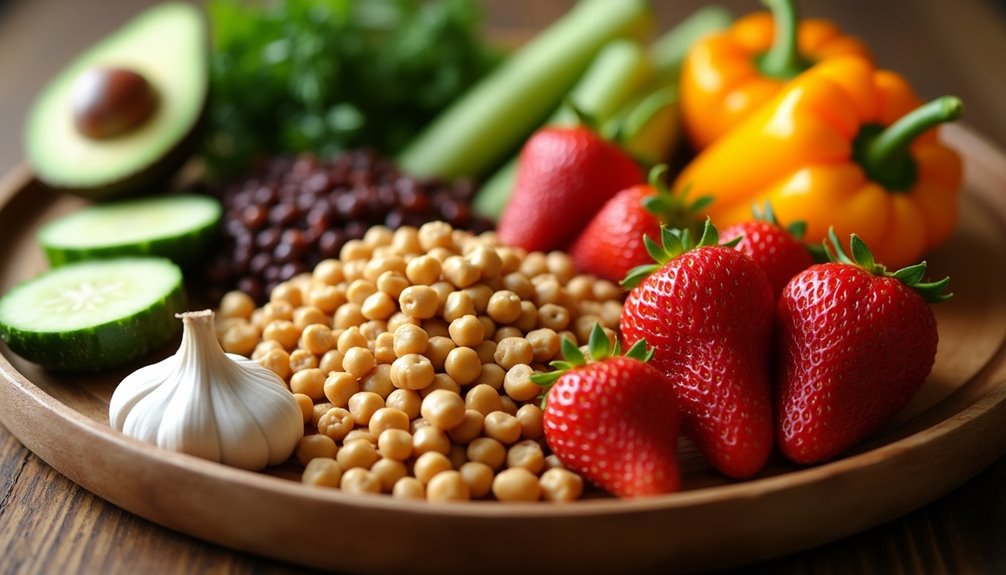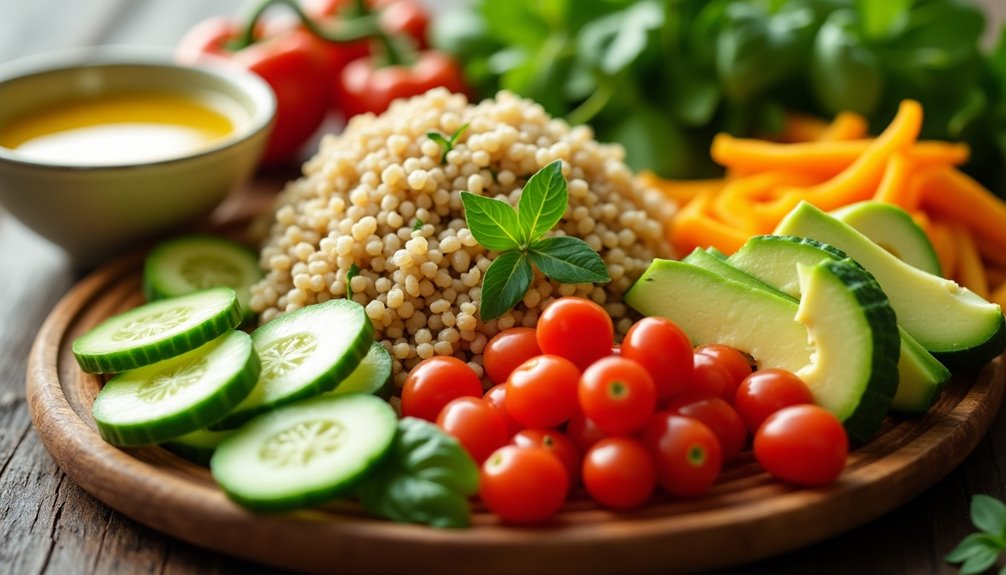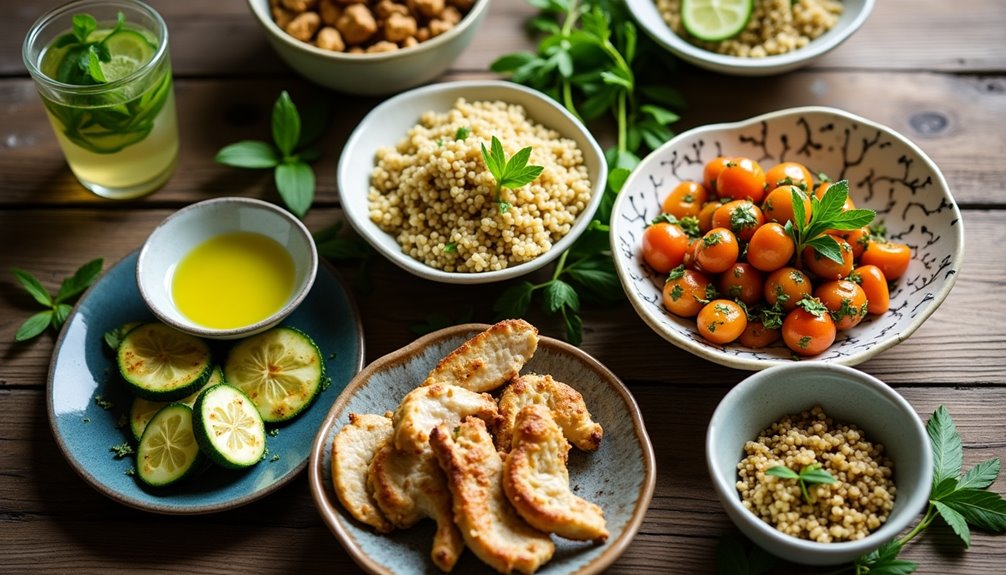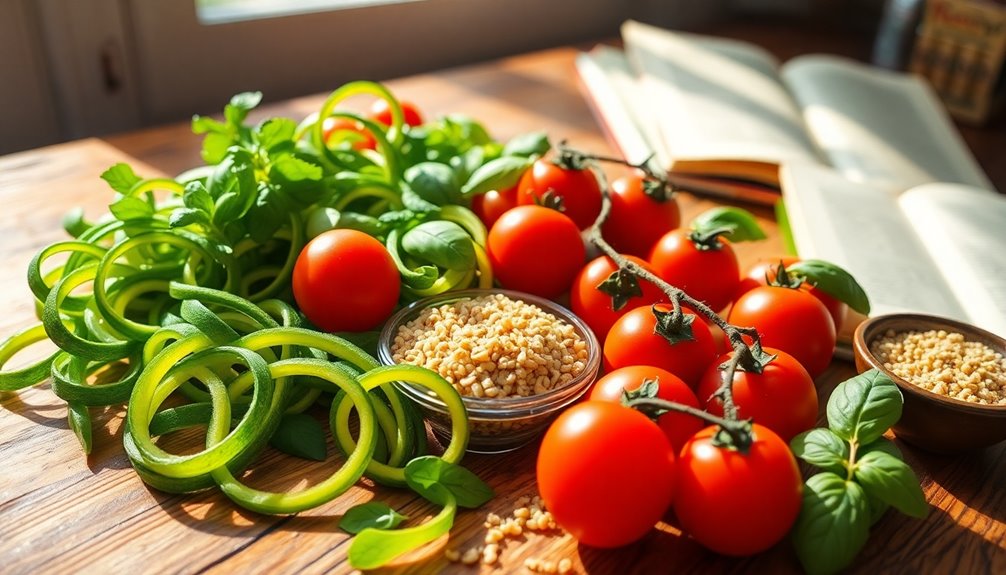The Low-FODMAP Diet helps you reduce digestive discomfort by limiting fermentable carbohydrates found in many fruits, vegetables, and grains. These FODMAPs can lead to bloating and gas, especially if you have IBS. By shifting to low-FODMAP options like bananas, carrots, rice, and chicken, you can improve your digestion and overall well-being. To succeed, plan your meals, read labels to avoid high-FODMAP ingredients, and consider keeping a food diary. This diet not only eases symptoms but also helps you pinpoint your trigger foods, paving the way for lasting improvements. Keep exploring for more tips and food options to enhance your journey.
Key Takeaways
- The Low-FODMAP diet helps manage digestive issues like bloating and IBS by reducing fermentable carbohydrates in the diet.
- It includes low-FODMAP foods such as bananas, carrots, rice, chicken, and lactose-free dairy alternatives.
- Meal planning and food prep are essential for success on the Low-FODMAP diet to maintain variety and avoid high-FODMAP foods.
- Learning to read labels and understanding serving sizes is crucial to avoid high-FODMAP ingredients.
- Keeping a food diary can help identify trigger foods and track dietary progress on the Low-FODMAP diet.
What Are FODMAPs?

FODMAPs, an acronym for fermentable oligosaccharides, disaccharides, monosaccharides, and polyols, are a group of short-chain carbohydrates that can cause digestive issues for some people. If you've ever experienced bloating, gas, or discomfort after meals, you might want to ponder how FODMAPs impact your digestive health. These carbohydrates aren't fully absorbed in the small intestine, leading to fermentation by gut bacteria, which produces gas and other symptoms.
Understanding FODMAPs is crucial for anyone looking to enhance their digestive well-being. They're found in a variety of foods, including certain fruits, vegetables, grains, and sweeteners. For example, foods high in oligosaccharides include wheat and legumes, while lactose in dairy products is a common disaccharide. When these foods are consumed, they can trigger digestive distress due to how they interact with the gut bacteria in your system.
By recognizing which foods contain FODMAPs, you can better manage your symptoms. This isn't about restriction but about empowerment—knowing what works for your body and what doesn't. You might discover that some FODMAPs are more problematic for you than others, leading you to make informed choices that support your digestive health. Additionally, staying hydrated with SlimCrystal bottles of slimming water can aid in overall health and vitality, which may complement your dietary adjustments.
Ultimately, understanding FODMAPs can help you foster a healthier relationship with food. Remember, you're not alone on this journey. Many people are facing similar challenges, and together, you can share tips and experiences that lead to better digestive health.
Benefits of the Low-FODMAP Diet

Adopting a low-FODMAP diet can greatly enhance your digestive health if you struggle with issues like bloating or gas. This approach targets specific carbohydrates that can ferment in your gut, leading to discomfort. By reducing these triggers, you can experience a noticeable improvement in your overall gut health and find relief from persistent digestive issues.
Here's a quick overview of the benefits you might experience:
| Benefit | Description | Impact on Daily Life |
|---|---|---|
| Reduced Bloating | Diminished fermentation leads to less gas. | You may feel lighter and more comfortable. |
| Improved Digestion | Easier digestion due to fewer triggers. | You might enjoy meals without discomfort. |
| Enhanced Nutrient Absorption | Less irritation allows for better nutrient uptake. | You could feel more energetic and healthier. |
| Decreased IBS Symptoms | Many report a reduction in IBS-related pain. | You may find it easier to engage in activities you love. |
| Personalized Food Choices | Discovering low-FODMAP options can be enjoyable. | You might feel empowered to explore new recipes. |
Choosing a low-FODMAP diet is not just about restrictions; it's about reclaiming your gut health. You'll likely find a supportive community of others tackling similar digestive issues. Sharing experiences can foster a sense of belonging, reminding you that you're not alone on this journey. Embracing this diet can lead to lasting changes, making everyday life more enjoyable and comfortable. Additionally, incorporating healthy recipes and meal ideas into your routine can make the transition to a low-FODMAP diet even more satisfying.
High-FODMAP Foods to Avoid

When following a low-FODMAP diet, identifying and avoiding high-FODMAP foods that can trigger digestive discomfort is crucial. Being aware of these trigger foods will assist you in making better choices during meal planning and when dining out.
Here are three common high-FODMAP foods to steer clear of:
- Certain Fruits: Apples, pears, and watermelons are high in fructose, which can lead to bloating and gas.
- Dairy Products: Milk, yogurt, and soft cheeses often contain lactose, a common trigger for many individuals.
- Wheat Products: Foods like bread, pasta, and cereals made from wheat can contain high levels of fructans.
Finding suitable substitutions is vital for maintaining a balanced diet. For instance, consider opting for berries instead of high-fructose fruits, or lactose-free yogurt as a dairy alternative. When it comes to meal planning, focus on whole foods like lean meats, eggs, and low-FODMAP vegetables such as spinach and carrots.
Moreover, be mindful that traditional bread can lead to significant blood sugar spikes, affecting overall health and digestion. Dining out can be challenging, but with a little preparation, it's manageable. Don't hesitate to ask the restaurant staff about ingredients or request modifications to your meal to avoid high-FODMAP items. By being proactive about your choices, you can enjoy meals with friends and family while still adhering to your low-FODMAP guidelines. Remember, you're not alone on this journey; many share similar experiences and find success with a little effort and creativity.
Low-FODMAP Food Options

Finding low-FODMAP food options is crucial to managing your digestive health while still enjoying a varied diet. You'll discover that there are plenty of delicious foods available, allowing you to create satisfying meals without compromising your well-being.
Start by stocking up on low-FODMAP fruits like bananas, blueberries, and strawberries, all of which can add sweetness to your breakfast or snacks.
When it comes to vegetables, think about carrots, spinach, and zucchini. These options aren't only nutritious but also versatile for various recipe ideas.
For grains, select rice, quinoa, and gluten-free oats, which can serve as great bases for your meals.
Protein sources are essential too. Chicken, turkey, and firm tofu are low-FODMAP options that can easily be included in your meal prep. Incorporate herbs and spices like basil, thyme, and ginger to enhance flavors without adding FODMAPs.
Don't forget about dairy alternatives. Lactose-free milk, hard cheeses, and almond milk can help you create creamy dishes without discomfort.
Consider planning your meals in advance. Meal prep is a fantastic strategy to guarantee you always have low-FODMAP options on hand. Prepare and portion out dishes like stir-fries or grain bowls, making it easier to stick to your dietary goals. Additionally, adopting a plant-based diet can reduce greenhouse gas emissions and support your digestive health.
With these low-FODMAP food options and creative recipe ideas, you can enjoy a fulfilling diet while taking care of your digestive health. Embrace this journey; you're not alone, and your health is worth the effort!
Tips for Success on the Diet

Success on the low-FODMAP diet hinges on meticulous planning and awareness of your food choices. To navigate this dietary journey effectively, consider these practical tips that can help you stay on track while also enjoying meals with friends and family.
- Meal Planning: Start each week by organizing your meals. This not only saves time but also reduces the temptation to grab high-FODMAP foods. Create a shopping list based on your meal plan to confirm you have everything you need. Include a variety of low-FODMAP foods to keep your meals exciting. Additionally, incorporating plant-based recipes can offer delicious and satisfying meal options that align with both diets.
- Learn to Read Labels: Familiarize yourself with reading ingredient labels. Many packaged foods contain high-FODMAP ingredients that can trigger symptoms. Focusing on whole foods like fruits, vegetables, and proteins can simplify your grocery shopping and meal prep.
- Eating Out: Dining out doesn't have to derail your diet. Before you go to a restaurant, check the menu online and identify low-FODMAP options. Don't hesitate to ask your server questions about ingredients or request modifications to dishes. Many restaurants are accommodating and will happily adjust meals to suit your dietary needs.
Frequently Asked Questions
Can I Eat Out While Following a Low-Fodmap Diet?
Yes, you can definitely eat out while following a specific diet. Start by researching restaurant options that offer customizable meals.
When meal planning, focus on places that provide fresh ingredients and clear menu descriptions. Don't hesitate to ask servers about ingredients or modifications to guarantee your meal aligns with your dietary needs.
Many restaurants are accommodating, and with a little preparation, you'll enjoy dining out without compromising your health goals.
How Long Should I Follow the Low-Fodmap Diet?
You should typically follow a restrictive diet for about 4 to 6 weeks. This timeframe allows you to notice any improvements in your symptoms. After that, you'll want to start food reintroduction, testing one food at a time to identify triggers.
It's important to take into account the long-term effects of dietary choices, so listen to your body and adjust as needed. Seeking support from a healthcare professional can also help you navigate this process effectively.
Are There Any Supplements I Can Take?
Ever tried Googling "best supplements" and felt overwhelmed? You've got some solid supplement options to ponder.
Probiotics can help balance gut bacteria, while digestive enzymes might ease some discomfort. Just be mindful of your dietary restrictions, as not all supplements suit everyone.
It's essential to chat with a healthcare professional to find what truly works for you, ensuring you stay healthy and feel like you belong in your wellness journey.
Is the Low-Fodmap Diet Suitable for Children?
Absolutely, the diet can be suitable for children when done correctly. You can plan family meals that include low-FODMAP foods, ensuring your kids get balanced nutrition. For school lunches, focus on easy-to-pack options like rice cakes, nut butter, and fresh fruits. It's important to consult a pediatrician or dietitian to tailor the approach to your child's needs. This way, you create a supportive environment while promoting healthy eating habits.
Can I Consume Alcohol on a Low-Fodmap Diet?
You might wonder if you can enjoy alcohol at social events while following a specific diet. The truth is, some alcoholic beverages can fit into your plan without causing issues. Stick to options like spirits and dry wines, but avoid high-FODMAP mixers and sweet wines.
Always check how your body reacts, as individual tolerances vary. It's all about balance—enjoying yourself while being mindful of your choices keeps you connected with friends and family.
Conclusion
Embracing a low-FODMAP diet can feel like discovering a hidden garden, lush with vibrant, digestive-friendly foods. By steering clear of high-FODMAP triggers, you're not just alleviating discomfort; you're nurturing your gut health and reclaiming joy in eating. With careful planning and creativity, you can craft meals that delight your taste buds while supporting your well-being. So take the plunge into this flavorful journey—your gut will thank you, and you'll bloom into a healthier you.



